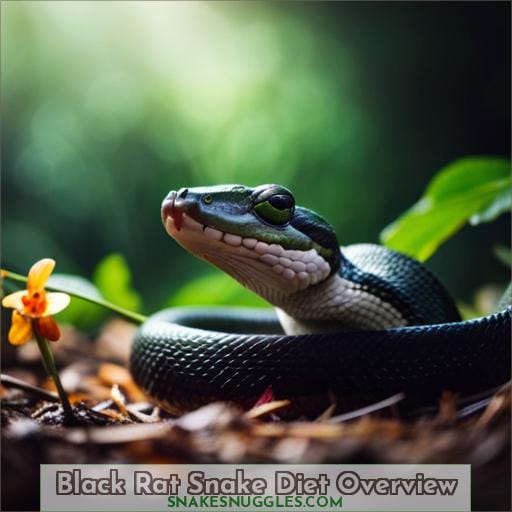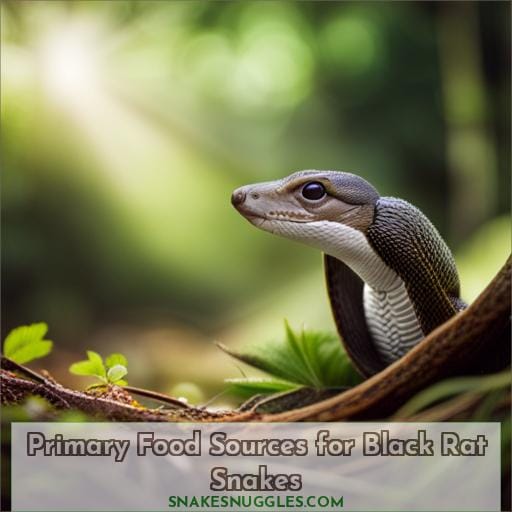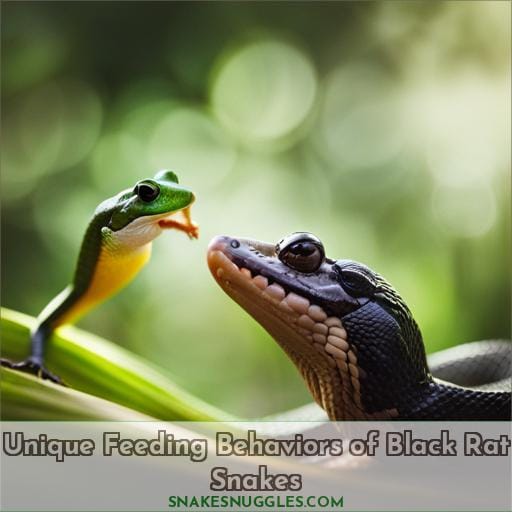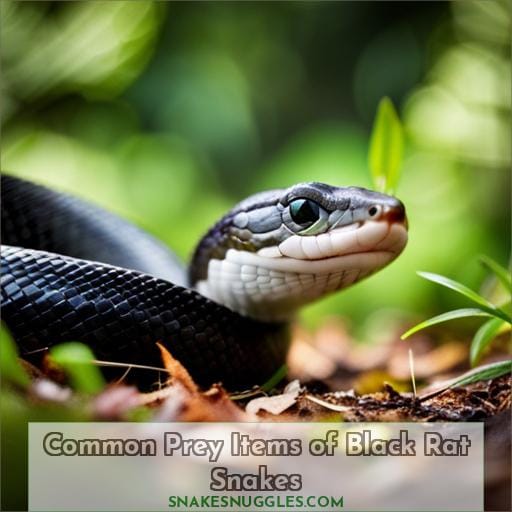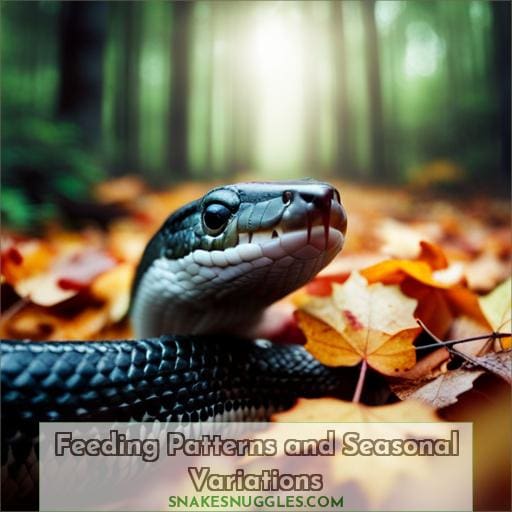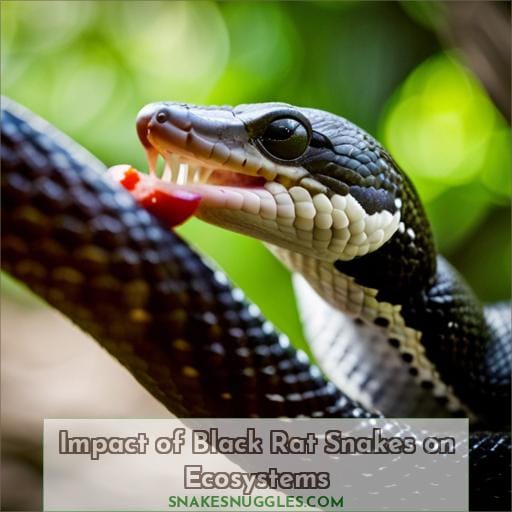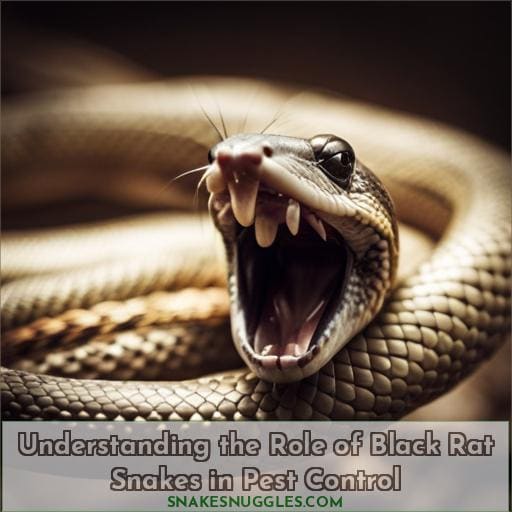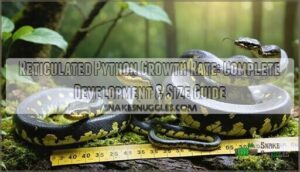This site is supported by our readers. We may earn a commission, at no cost to you, if you purchase through links.
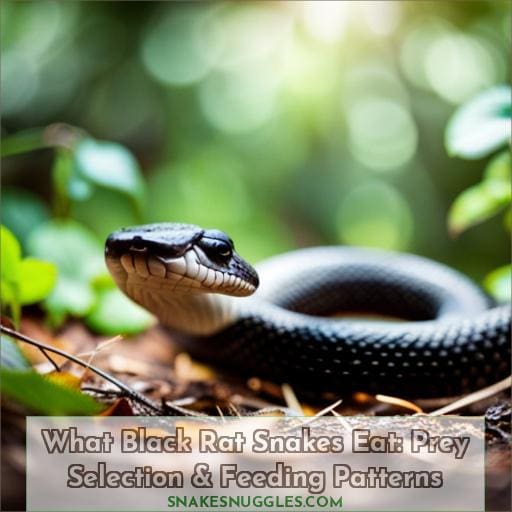 Discover what black rat snakes eat and gain insight into their prey selection and feeding patterns.
Discover what black rat snakes eat and gain insight into their prey selection and feeding patterns.
These native snakes, found in the central and eastern United States, have a diverse diet that includes:
- Small mammals
- Birds and their eggs
- Amphibians
- Reptiles
Using constriction techniques to overpower their prey, these powerful non-venomous snakes play a crucial role in maintaining ecosystem balance by controlling rodent populations.
Dive into this article to learn more about the fascinating feeding habits of black rat snakes.
Table Of Contents
- Key Takeaways
- Black Rat Snake Diet Overview
- Primary Food Sources for Black Rat Snakes
- Unique Feeding Behaviors of Black Rat Snakes
- Common Prey Items of Black Rat Snakes
- Feeding Patterns and Seasonal Variations
- Impact of Black Rat Snakes on Ecosystems
- Understanding the Role of Black Rat Snakes in Pest Control
- Frequently Asked Questions (FAQs)
- How do black rat snakes catch and subdue their prey?
- Are there any other factors that influence the diet of black rat snakes besides availability?
- Do black rat snakes have any specific hunting strategies or techniques?
- How often do black rat snakes need to eat to sustain themselves?
- Are there any notable differences in the diet of black rat snakes based on their geographical location?
- Conclusion
Key Takeaways
- Black rat snakes are opportunistic predators that target small rodents like mice, rats, chipmunks, and squirrels.
- They have a diverse diet that includes frogs, lizards, birds, and eggs.
- Prey selection is influenced by habitat, and they utilize various hunting techniques.
- Black rat snakes play an essential role in maintaining ecosystem balance by controlling rodent populations.
Black Rat Snake Diet Overview
When it comes to the diet of black rat snakes, their feeding habits are quite general.
They’re known to be opportunistic predators that primarily target small rodents such as mice and rats.
However, they also consume other prey items like frogs, lizards, birds, and even eggs when available.
The frequency of their feeding varies depending on factors such as prey availability and seasonal changes in activity levels.
General Feeding Habits
When it comes to their diet, black rat snakes have a preference for consuming small mammals, birds and eggs, amphibians and reptiles.
- Selecting prey based on availability in their habitat.
- Utilizing various hunting techniques such as ambush predation or actively searching for food.
- Maintaining predator-prey relationships that contribute to the balance of ecosystems by controlling populations of rodents, birds, and amphibians.
These feeding habits play a crucial role in maintaining ecosystem balance while satisfying the nutritional needs of black rat snakes.
Prey Selection
To understand the diet of black rat snakes, it’s important to delve into their prey selection.
Black rat snakes exhibit a diverse range of foraging strategies and behavioral adaptations that enable them to effectively hunt and capture their preferred prey.
These predators primarily target small mammals such as mice and rats, but they also consume birds, eggs, amphibians, and reptiles.
Their habitat preferences play a crucial role in shaping their ecological impact as efficient rodent controllers within various ecosystems.
Feeding Frequency
To understand the feeding frequency of black rat snakes, it’s important to recognize that they’ve a regular and consistent appetite for their prey.
Black rat snakes are opportunistic feeders with a varied diet consisting primarily of small mammals, birds, amphibians, and reptiles.
Their feeding cycles are influenced by seasonal changes in prey availability.
During active months, black rat snakes consume multiple meals per week to meet their energy requirements.
However, their feeding frequency decreases significantly during hibernation when food sources become scarce.
Understanding the feeding patterns and seasonal variations of black rat snakes provides valuable insights into their role as predators in maintaining ecosystem balance.
Primary Food Sources for Black Rat Snakes
Black rat snakes primarily feed on three main food sources:
- Small mammals
- Birds and their eggs
- Amphibians/reptiles
As an opportunistic predator, they’re skilled hunters that rely on their keen senses to locate and capture prey.
- Mice
- Rats
- Voles
- Squirrels
- Various bird species such as sparrows or robins.
Additionally, they’ll consume frogs and lizards when available in their environment.
Small Mammals
You’ll find that black rat snakes primarily target small mammals as their primary food source. These predators play a crucial role in prey dynamics and ecosystem dynamics by regulating population sizes of their preferred prey species.
Their diet consists mainly of mice, rats, chipmunks, and squirrels. By consuming these small mammals, black rat snakes help maintain balance in the wildlife interactions within their habitat while also impacting the overall ecosystem positively through population regulation.
Birds and Eggs
Black rat snakes primarily rely on birds and their eggs as a primary food source. This preference for avian prey has significant implications for various aspects of the snake’s behavior and ecology.
Here are four key insights into how black rat snakes interact with birds and their eggs:
- Nest predation: Black rat snakes are skilled nest predators, often targeting bird nests to consume both the eggs and hatchlings.
- Avian impact: The presence of black rat snakes can have a substantial impact on local bird populations, particularly nesting success rates.
- Breeding implications: The threat of nest predation by black rat snakes can influence the breeding behaviors of birds, leading to adaptations in nesting site selection or increased vigilance during incubation.
- Foraging habits: When hunting for avian prey, black rat snakes exhibit specialized behaviors such as climbing trees or shrubs to access nests while also actively searching forested areas where they may encounter ground-nesting species.
Understanding these dynamics is crucial not only in comprehending the feeding patterns of black ratsnakes but also in appreciating their role within ecosystems that involve interactions between predator-prey relationships among reptiles and avianspecies.
Amphibians and Reptiles
As we delve further into the prey selection of black rat snakes, it’s important to highlight their primary food sources: amphibians and reptiles.
Black rat snakes exhibit behavioral adaptations that allow them to thrive in diverse habitats, contributing to habitat diversity and ecological balance.
By consuming amphibians such as frogs and reptiles like lizards, black rat snakes play a crucial role in predator-prey dynamics while also impacting the environment positively through rodent population control.
Unique Feeding Behaviors of Black Rat Snakes
Black rat snakes exhibit unique feeding behaviors that contribute to their success as predators.
One notable behavior is their use of constriction techniques to subdue and immobilize prey before consumption, a skill they’ve perfected over time.
Additionally, black rat snakes display opportunistic feeding habits, consuming a variety of prey including mice, small rodents, frogs, lizards, birds, and even eggs when available.
Lastly, but not least importantly, in certain situations where food sources are limited or scarce they may resort to cannibalism by preying on other smaller snake species.
Constriction Technique
To understand the unique feeding behaviors of black rat snakes, let’s delve into their impressive constricting technique.
This predatory mechanic is a crucial survival adaptation that allows them to efficiently immobilize their prey.
Through muscular constriction, black rat snakes are able to restrict blood flow and breathing in their victims, ultimately leading to successful predation.
Opportunistic Feeding
When it comes to feeding, black rat snakes exhibit opportunistic behaviors that allow them to take advantage of a wide range of available prey items. Their foraging behavior is characterized by flexibility and adaptability, making them skilled hunters.
These snakes have diverse prey preferences, including:
- Small mammals like mice and rats
- Birds and their eggs
- Amphibians and reptiles
This dietary adaptation enables them to thrive in various environments while also contributing positively to wildlife management through pest control efforts.
Cannibalism
Moving on to the unique feeding behaviors of black rat snakes, one of their notable tendencies is cannibalism. Cannibalism among black rat snakes has significant behavioral implications and ecological significance.
While it may seem unusual for a species to consume its own kind, this behavior has evolutionary considerations and feeding strategies tied to it. Understanding the impact of cannibalism on black rat snake populations helps shed light on their complex feeding patterns and provides insights into their role in ecosystem dynamics.
Common Prey Items of Black Rat Snakes
When it comes to the diet of black rat snakes, they have a wide variety of common prey items.
Mice and rats are among their primary targets, as these small rodents provide ample nutrition.
Additionally, chipmunks and squirrels are also on the menu for black rat snakes due to their availability in wooded areas.
Furthermore, birds and their eggs serve as another important food source for these snakes, providing them with essential protein during breeding seasons.
Mice and Rats
You’ll often find black rat snakes hunting and devouring mice and rats in their natural habitats.
These carnivorous tendencies make rodents a significant part of their prey consumption.
Black rat snakes are efficient mouse hunters, using their keen senses to track down these small mammals.
The rat diet of black rat snakes contributes to rodent predation, helping control populations in various ecosystems through selective feeding patterns.
Chipmunks and Squirrels
Continuing with the discussion on the prey items of black rat snakes, let’s now focus on chipmunks and squirrels.
Chipmunks, known for their quick movements and burrowing behavior, often fall victim to the predatory strategies employed by black rat snakes.
Squirrels, occupying various habitats such as trees and fields, are also common targets due to their abundance in certain areas.
These interactions between black rat snakes and these small mammals have significant implications for ecosystem balance.
Birds and Their Eggs
To continue discussing the common prey items of black rat snakes, they also frequently target birds and their eggs. Avian predation is an important aspect of their feeding patterns, with bird eggs being a valuable food source.
Here are three key points about black rat snakes and their interactions with birds and their eggs:
- Nesting Predators: Black rat snakes are known to raid bird nests in search of both adult birds and vulnerable eggs.
- Egg Deposition: These snakes have adapted to locate concealed spots where avian parents deposit their precious offspring, allowing them easy access to this nutritious resource.
- Predator Impact on Avian Conservation: The presence of black rat snakes can pose challenges for avian conservation efforts due to potential declines in local bird populations caused by predation on nesting sites.
Understanding the relationship between black rat snakes, birds, and their eggs helps us appreciate the complexity of predator-prey dynamics while emphasizing the importance of preserving avian habitats for conservation purposes.
Feeding Patterns and Seasonal Variations
Feeding patterns of black rat snakes vary throughout the year, with active months characterized by regular feeding and reduced feeding during hibernation.
During the warmer seasons, these snakes employ different strategies to secure their prey, such as actively hunting for mice and small rodents.
However, in colder months when they enter hibernation, their metabolic rate decreases significantly leading to a decreased need for food intake.
Feeding During Active Months
During the active months, black rat snakes maintain their feeding patterns and exhibit preferences for specific prey items. Their feeding cycles are influenced by seasonal changes and availability of food sources.
Black rat snakes are opportunistic hunters, using a combination of ambushing and actively searching for prey. They primarily target small mammals such as mice and rats, but also consume birds, eggs, amphibians, and reptiles during this time.
These feeding patterns ensure they meet their nutritional needs throughout the active months.
Reduced Feeding in Hibernation
You’ll notice that black rat snakes feed less frequently during hibernation. This reduction in feeding is a result of their physiological adaptations to survive the harsh winter conditions.
During hibernation, black rat snakes enter a state of torpor called brumation, where their metabolic rate slows down significantly.
Their decreased appetite and winter fasting help them survive the cold weather when prey availability is limited.
Feeding Strategies in Different Seasons
As the seasons change, black rat snakes adapt their feeding strategies to meet the fluctuating availability of prey. Seasonal feeding dynamics are influenced by environmental factors and drive these adaptive hunting strategies.
In winter, when food sources are scarce, black rat snakes employ specific tactics to survive. These behavioral responses include reduced activity levels and a reliance on stored energy reserves until prey becomes more abundant in warmer months.
Impact of Black Rat Snakes on Ecosystems
Black rat snakes play a crucial role in controlling rodent populations, making them valuable assets in maintaining ecosystem balance.
By preying on rodents, these snakes help regulate their numbers and prevent overpopulation that can have detrimental effects on agricultural crops and human settlements.
Additionally, black rat snakes also impact bird and amphibian populations as part of their diverse diet, contributing to the overall ecological stability within their habitats.
Rodent Population Control
Black rat snakes play a crucial role in controlling rodent populations, making them valuable assets to ecosystems.
By preying on rodents such as mice and rats, black rat snakes contribute to maintaining predator-prey dynamics and ensuring ecosystem harmony.
Their natural pest control abilities help prevent excessive rodent populations that can negatively impact agricultural settings and residential areas.
This biodiversity impact highlights the importance of wildlife coexistence and effective pest management strategies.
Influence on Bird and Amphibian Populations
By consuming birds and amphibians, black rat snakes play a significant role in influencing populations within ecosystems. Their impact on bird and amphibian populations is crucial for maintaining ecological balance and biodiversity influence.
Here are four ways in which black rat snakes influence these populations:
- Avian Predation: Black rat snakes prey on birds, especially chicks, impacting their population sizes.
- Amphibian Impact: These snakes also consume amphibians such as frogs, affecting their abundance within ecosystems.
- Ecosystem Dynamics: By regulating bird and amphibian numbers, black rat snakes contribute to the overall dynamics of the ecosystem.
- Biodiversity Influence: The presence of black rat snakes helps ensure a diverse range of species by controlling certain avian and amphibious populations.
Through their feeding patterns targeting birds and amphibians, black rat snake’s actions have far-reaching consequences for maintaining ecosystem health by preserving ecological balance through biodiversity influence.
Role in Maintaining Ecosystem Balance
Black rat snakes play a crucial role in maintaining ecosystem balance.
As opportunistic predators, they help regulate populations of small mammals, birds, eggs, and amphibians. This influences biodiversity and wildlife coexistence through ecological equilibrium.
As biodiversity guardians, black rat snakes contribute to harmony between predator and prey dynamics.
Understanding the Role of Black Rat Snakes in Pest Control
As an opportunistic and voracious predator of rodents, the black rat snake contributes substantially to managing populations of rats and mice, which may wreak havoc in agricultural and residential settings.
We’ll examine the benefits of the black rat snake’s feeding patterns in naturally controlling common household and farm pests without relying on chemical solutions. This species’ predatory impact outlines an environmentally-friendly approach to integrated pest management.
Benefits in Agricultural Settings
You’ll usually find black rat snakes in agricultural settings since they excel at controlling rodent populations that threaten crops and livestock.
These eco-friendly pest controllers are farming allies, contributing to agricultural harmony by keeping pests at bay.
The presence of black rat snakes provides a natural form of pest management, reducing the need for chemical interventions.
Their role in controlling rodent populations also promotes biodiversity and ensures a safer environment for farmers and their crops.
Residential Pest Management
To effectively manage pests in your home, it’s important to understand the valuable role that black rat snakes play in pest control.
Black rat snakes are natural predators of rodents and other common household pests, making them an effective and eco-friendly solution for residential pest management.
These non-venomous snakes help keep populations of mice, rats, and other unwanted creatures under control, preventing potential home invasions and minimizing the need for chemical pesticides.
Consider adopting a black rat snake as a pet or encouraging their presence around your property to benefit from their natural pest control abilities.
Natural Pest Control Solutions
One effective solution for natural pest control is utilizing the predatory instincts of black rat snakes.
These eco-friendly pest controllers play a vital role in maintaining wildlife harmony and supporting biodiversity.
By preying on pests such as rodents, birds, and amphibians, they contribute to sustainable agriculture practices while helping maintain ecological balance.
Their efficient prey selection and feeding patterns make them an invaluable asset for natural pest control solutions.
- Eco-friendly Pest Control
- Wildlife Harmony
- Biodiversity Support
- Sustainable Agriculture
- Ecological Balance
Frequently Asked Questions (FAQs)
How do black rat snakes catch and subdue their prey?
Black rat snakes catch and subdue their prey by utilizing constriction, a non-venomous method.
They coil around their target, tightening the grip to prevent escape or breathing until the prey is immobilized and ready for consumption.
Are there any other factors that influence the diet of black rat snakes besides availability?
Factors that influence the diet of black rat snakes, besides prey availability, include environmental conditions and seasonal changes. This affects the abundance and accessibility of certain food sources, shaping their feeding habits accordingly.
Do black rat snakes have any specific hunting strategies or techniques?
Black rat snakes employ various hunting strategies to capture their prey.
They rely on stealth, patience, and quick strikes to ambush rodents and other small animals.
Their anachronistic technique is reminiscent of ancient predators stalking their unsuspecting targets in the wild.
How often do black rat snakes need to eat to sustain themselves?
Black rat snakes typically need to eat every 1-2 weeks to sustain themselves.
Their diet consists primarily of mice, rats, and other small rodents.
This regular feeding ensures their energy needs are met for survival and growth.
Are there any notable differences in the diet of black rat snakes based on their geographical location?
Based on geographical location, black rat snakes may exhibit slight dietary variations. Factors such as prey availability and habitat influence their diet. Further research can provide more specific insights into these regional differences.
Conclusion
To understand the diverse feeding habits of black rat snakes, it’s essential to delve into their prey selection and feeding patterns.
These fascinating native snakes, found in the central and eastern United States, have a varied diet that includes:
- Small mammals
- Birds and their eggs
- Amphibians
- Reptiles
By utilizing constriction techniques to overpower their prey, black rat snakes play a crucial role in maintaining ecosystem balance by controlling rodent populations. Their impact on the ecosystem, particularly in pest control, highlights the importance of these snakes in our natural environments.

